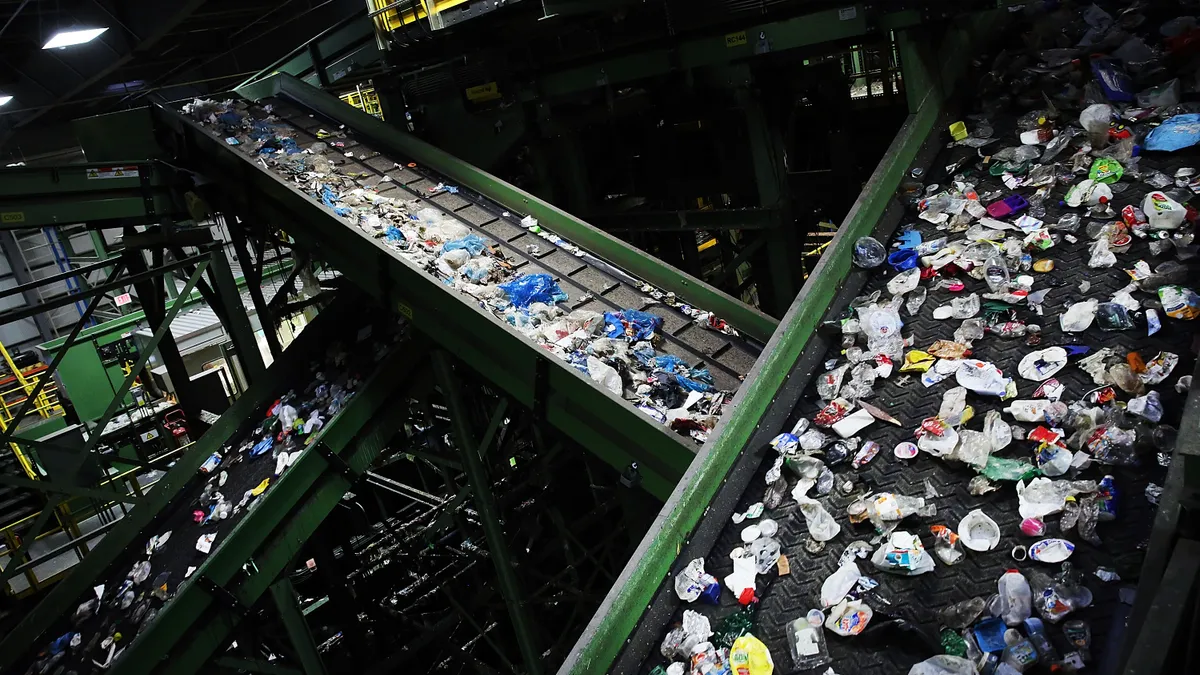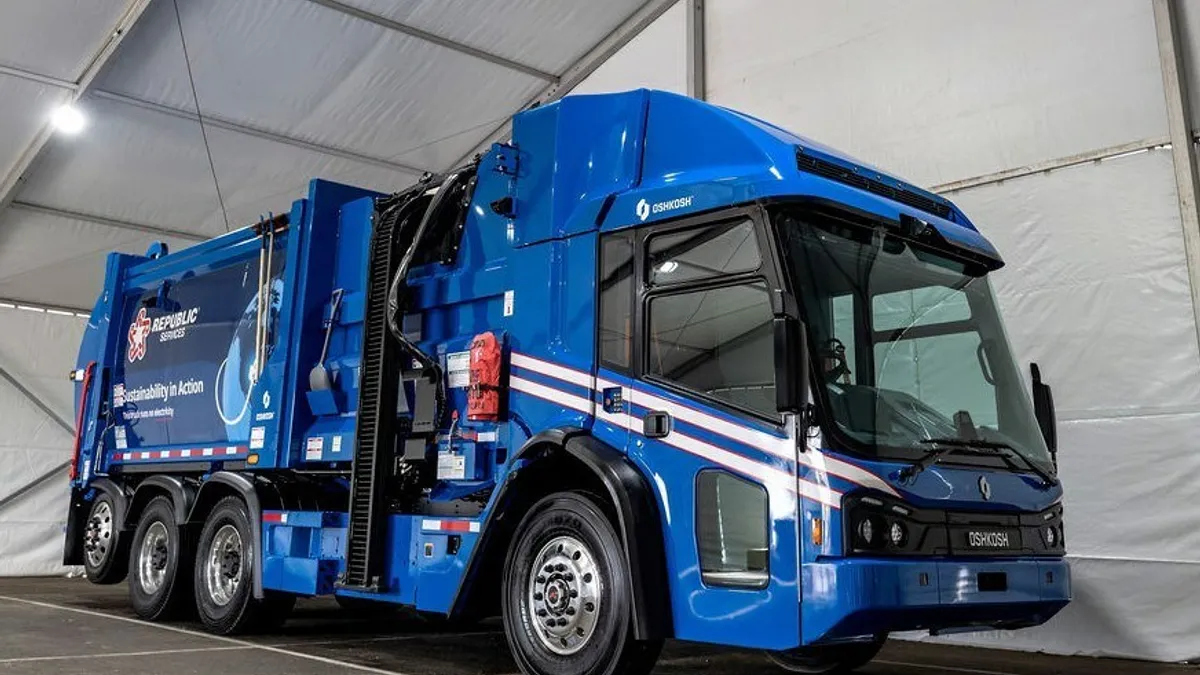Editor's Note: The following is a contributed piece and does not represent Waste Dive's editorial views. More information on how what that entails, and how you can submit one, is available here.
Over the last six months, Chinese contamination limits have put an immense amount of pressure on the U.S. recycling industry. We’ve seen legislative changes, material piling up at MRFs and profitability issues for all major waste operators in their recycling segments.
By now it seems clear the U.S. recycling industry must adapt to new circumstances. Otherwise, the pressure will continue as Southeast Asian countries grow into stronger negotiating positions and Chinese investments into recycling infrastructure release the current tension on virgin pulp prices. Meanwhile, local governments and waste operators continue to bicker about contamination rates and pricing.
The waste industry must make some radical changes and decision-makers may have more options than they realize, ranging from small practical changes to larger paradigm shifts, that could make recycling a higher portion of revenue in future years.
Two key pillars must be in place for any strategy to be effective — it must be sustainable and it must be economically viable. Without keeping those two factors in mind, temporary decisions will get made that aren't viable enough to attract resources for innovation.
To truly fix the recycling industry, while also keeping short-term operations as smooth as possible, businesses should keep three concepts in mind.
1. Implement and leverage temporary fixes with a clear emphasis on flexibility
Temporary fixes have been the natural first reaction of many industry participants, and a prime example of that is moving materials to new countries in Southeast Asia. This presents a few issues.
The current approach seems to be a race for each exporter to drive as much as volume as possible with little-to-no apprehension of maintaining access to these foreign markets long-term. This had led to many Southeast-Asian countries considering waste bans of their own, or restricting imports in other ways due to a saturation of inbound material. If the remaining importers begin to cut down on a regulatory level then the U.S. industry is truly facing a bumpy future in the short-term.
The first issue is the inherent prisoner's dilemma. While all operators would be better served by not pressuring importing countries, they also know that if they slack their own imports, a competitor may simply grab their volume. This is a phenomenon any economics beginner will recognize as the “tragedy of the commons.”
The best solution seems to be agreeing on a set of volume and quality constraints imposed on all operators with the help of a currently recognized trade association. Exporters would still broker the business but, similar to fishing quotas, the agreement would protect end-market integrity. The primary obstacle to this is that operators such as Waste Management, who currently have an advantage with their waste brokerage division, would have to give up a small competitive advantage to benefit the whole.
The second issue is the current fixes are largely linear. If participants manage to ship an incremental amount of material to a port, it only fixes shipments for that month. Industry participants must leverage the temporary fix into building multiple long-term markets instead of simply attempting to survive.
If the industry managed to motivate growth in local recycling capabilities, each month of shipments could lead to greater capacity the next month. To change this equation, exporters need to motivate capital investment in Southeast Asian countries through long-term contracts that promise a stable amount of scrap exports at acceptable rates.
In the end this demand could also spur domestic growth in U.S. processing for a range of materials, but the required capital investment out of shareholder's pockets will take time to materialize.
2. Reconstruct the industry to accommodate commercial players
A large percentage of shareholders in waste stocks are there for the stable and growing capital return through dividends and stock buybacks. Stability through inflation-protected contracts, an ability to reinvest capital, and economics of density have all driven large amounts of capital back into the traditional solid waste business.
Pensioners can rely on companies such as Waste Management and Republic Services to pay a sum every year, almost no matter the economic circumstances. These shareholders would never want to transition their business into a volatile one that pays a large dividend one year and none the next year.
If recycling is ever to become a material percentage of revenue for waste operators, they need to have a business model that is somewhat equally attractive to their current alternative.
In my view, one challenge is that the recycling side of the industry hasn't received the same amount of love by capital allocators — from investors to corporate executives. Almost all major individuals in the industry seem to care about transitioning to recycling on a verbal level, but once it comes down to heavy capital reinvestment their commitment seems less intense.
I don’t believe executives and investors are hypocrites, but rather that they can’t find reasonable places to invest capital in large amounts when compared to capital returns or other avenues of reinvestment such as landfills. In its current state, the recycling industry is not a great place for waste operators to reinvest capital.
There are a few reasons for this and fixing them is a good first move toward reforming the recycling space.
One step is to fix the commodity-based business model. While the returns on capital over a full business cycle might not differ much, the cost of “investing” in a cyclical is a risk to the individual making the business decision.
The first step is to transition all contracts whose core profitability rely on commodity prices into alternate contract structures. This contract structure would also increase upside potential for local governments if commodity markets rebound, as the fees would remain fixed while income increased.
The second step to improving the attractiveness profile on a capital investment-basis is to continue building liquid secondary markets with derivatives for hedging commodity exposure.
The current market size for commodities like recycled mixed paper is enormous, but the financial sophistication is relatively low. A secondary market with liquid trading of futures for recycled pulp would increase stability through other means and allow producers throughout the value chain to allocate the commodity price risk to willing risk-takers.
This will require an exchange with price-quotes and rules for the commodities traded. A few exchanges (like NOREXECO) have sprung up, but most have been focused on a single commodity. Hedging opportunities with proper liquidity are only available on widely-traded virgin commodities, not their recycled cousins. Building a liquid secondary market with live quotes and derivatives will enhance stability. The obvious candidate for building this market would be INTL FCStone, but any experienced commercial hedging operator would also have the know-how.
Finally, the federal, state and local governments need to realize that they must not only permit, but support a profitable transition for waste operators. Instead of making waste operators “promise” recycling goals to acquire attractive disposal contracts, the recycling contracts themselves should (by all actionable means) be made attractive.
If local governments pressure operators down to the lowest profit-margin possible, only the worst capital allocators will want to remain in the space. If instead they decide to launch a win-win partnership with the private sector, billions in capital could move from capital return such as dividends to investments in improving MRFs and recycling processes.
The goal here isn't simply to survive National Sword, but to use it as a catalyst for permanent improvement. The current waste landscape has inflation protection, stable reinvestment opportunities and organic growth. When recycling can rival this business proposition, I have no doubt that industry professionals will commit heavily to the transition.
3. Diversion needs to be reduced materially for quality to go up
In states with high levels of environmental regulation, the term “diversion” is often hailed as the end-all be-all of waste politics. The more material that you can move from landfills to recycling facilities, the better, right? Perhaps in the short term, but in the long term there are adverse consequences.
We are taking care of the environment entirely for long-term reasons, so they are worth considering.
Artificially driven diversion usually equals a higher contamination rate. If you have a single-stream trash operation with 12 relatively clean materials then waste operators feel the safety to take on debt and finance expansion projects. Markets that may have hundreds of materials, with high levels of contamination, become vastly less attractive to invest in. When more capital needs to be put at risk for a lower chance of success, investments will decline.
The real goal is a recycling transition and you need more than one KPI for that. Instating a weighted metric using both diversion and contamination rates could help solve this. An alternative could be replacing the diversion metric entirely and moving the performance indicators down a level of abstraction. We measure diversion as a proxy for environmental impact of our disposal, but perhaps the easiest transition would be to look at actual environmental indicators.
All of these considerations come down to aligning incentives on both a short- and long-term basis. States and cities need to temporarily lower diversion goals and then set a planned schedule for increasing them. The schedule needs to be aggressive enough to require R&D, but start off slowly enough that major players feel willing to invest. An initial step could be a drastic reduction in single-stream material complexity by removing materials such as glass and then incrementally reintroducing them.
After all, the goal is to actually recycle and not simply pass on waste in a game of musical chairs worldwide. For this to occur the quality of recycling has to improve, which requires a diminishment in low-quality volume.
Positive changes to contamination levels would also send a possible signal to China. Given the current pressure on inventories in Chinese paper mills and rising virgin pulp prices, the Chinese government might become more accommodating.
Being proactive can also be profitable
As landfill capacity dwindles and waste generation escalates, an economically sustainable foundation becomes increasingly important. As the industry figures out its next move, the key goal is to align incentives so that U.S. operators can invest in research and assets without abandoning their fiduciary duty to shareholders. The operators have the profit, paying out hundreds of millions each year in buybacks and dividends. Now they need motivation to invest it in new ways.
Lower diversion, liquid secondary markets, improved contract structure and a dynamic method of implementing temporary fixes are some of the many necessary steps for securing a functional and attractive recycling industry.
Of course, U.S. officials and waste operators don’t have to become proactive and take responsibility for developing the future of recycling in a profitable manner. Though if they don’t the future will simply be created by the agents that act now. Currently, that appears to be China.
If we don’t want the future of recycling to be determined by foreign actors who care nothing for the US environment or business stability, cooperation should be seen as the highest virtue.
Matthias Herskind has previously covered the waste industry for Seeking Alpha and on the website Herskind & Agarwal. He is currently a student at Copenhagen Business School.





















